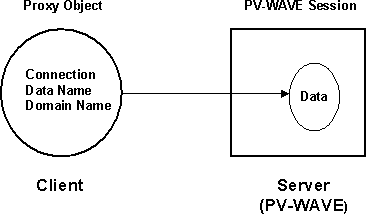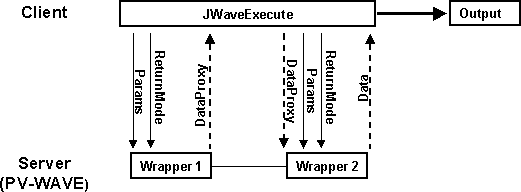Managing
Data
If you are working with large datasets, you probably want to keep them on the server. Typically, the server has the memory and storage resources that large datasets require. On the other hand, client machines typically have limited memory and storage capacity. Furthermore, the transfer of large datasets between the client and server (for example, across the Internet) can consume network resources.
JWAVE addresses this problem with data proxies. A proxy is an object-oriented design term that refers to a surrogate or placeholder that controls access to another object. A data proxy, then, is a surrogate object that refers to data.
If the data is, for instance, a large multidimensional array stored in a PV-WAVE session, the client can use a proxy object to refer to that data. Using a proxy object, the client can request operations to be performed on the data, such as:
What is a JWAVE Data Proxy
A Proxy class is an interface that describes a data proxy. The subclass of the Proxy class used by JWAVE clients to refer to data that is stored on the server is JWaveDataProxy.
Usually, a JWAVE wrapper function processes data in some way and stores the results. The JWAVE client may wish to use another JWAVE wrapper to perform further analysis on the stored results. To do this, the client needs to be able to reference the data stored on the server. The most efficient way to do this is to ask the server to return a data proxy, which the client can then use in the setParam method of subsequent function calls from the first wrapper.

Figure 6-1 A Proxy object refers to data stored in a PV-WAVE session. The proxy knows where to find the server (JWaveConnection), the name of the data domain name for the data (ServerDataID).
Instantiating a JWaveDataProxy Object
A
Other Ways to Instantiate a JWaveDataProxy Object
setParam(String name, Object value, ServerDataID dataName)
setParam(String name, ServerDataID dataName)
setReturnParamMode(String name, boolean returnVals, ServerDataID
dataName)
TIP: For detailed information on all of the constructors, variables, and methods of the JWaveDataProxy class, refer to the Javadoc reference. For information on Javadoc, see Using the JWAVE Javadoc Reference.
The Efficiency of Using Data Proxies
Inefficient System: The Data Makes Two Round Trips
Figure 6-2 Inefficient use of JWAVE, as data is physically passed between server and client
Efficient System: No Round Trips
Figure 6-3 Efficient use of JWAVE, as data is not physically passed between server and client
Setting the Return Parameter Mode
Example: Using
Data Proxies
Figure 6-4 illustrates the flow of this JWAVE application.

Figure 6-4 JWAVE scenario using data proxies
NOTE: This client application calls two different JWAVE wrapper functions on the server. From the first wrapper, the client asks for a proxy to be returned. From the second wrapper, the client asks for the actual data values, which it then prints.
The Java
Client Program
Example 6-1 proxyarry.java: Sends data to the server; retrieves a data proxy; uses the proxy in a subsequent JWaveExecute object
import com.visualnumerics.jwave.*;
public class ProxyArray {
public static void main(String[] args) {
try {
// Create a simple array as data
float[] arr = new float[10];
for (int i=0; i arr.length; ++i)
arr[i] = i;
// Connect to JWave server
JWaveExecute command = new JWaveExecute("PROX1");
// Set the data as ARRAY1 parameter
command.setParam("ARRAY1", arr);
// Ask that the result data (named DATA) be stored on the server,
// and only return a Proxy
ServerDataID saveData = new ServerDataID("SAVE_NAME");
command.setReturnParamMode("DATA", JWaveExecute.RETURN_NO_VALUES,
saveData);
// Execute PROX1
command.execute();
// Switch to new wrapper function
command.setFunction("PROX2");
// Clear previous parameters and return modes
command.clearParams();
command.clearReturnParamModes();
// Set input to PROX2 to use data stored by PROX1
// Could also use getReturnProxy("DATA") here rather than saveData
command.setParam("ARRAY2", saveData);
// Execute PROX2 and get result
command.execute();
float[] answer = (float[]) command.getReturnData("DATA");
// Print result
for (int i=0; i
arr.length; ++i)
arr[i] = i;
// Connect to JWave server
JWaveExecute command = new JWaveExecute("PROX1");
// Set the data as ARRAY1 parameter
command.setParam("ARRAY1", arr);
// Ask that the result data (named DATA) be stored on the server,
// and only return a Proxy
ServerDataID saveData = new ServerDataID("SAVE_NAME");
command.setReturnParamMode("DATA", JWaveExecute.RETURN_NO_VALUES,
saveData);
// Execute PROX1
command.execute();
// Switch to new wrapper function
command.setFunction("PROX2");
// Clear previous parameters and return modes
command.clearParams();
command.clearReturnParamModes();
// Set input to PROX2 to use data stored by PROX1
// Could also use getReturnProxy("DATA") here rather than saveData
command.setParam("ARRAY2", saveData);
// Execute PROX2 and get result
command.execute();
float[] answer = (float[]) command.getReturnData("DATA");
// Print result
for (int i=0; i answer.length; ++i)
System.out.println(answer[i]);
} catch (Exception e) {
// Report problems
System.out.println(e.toString());
}
}
}
answer.length; ++i)
System.out.println(answer[i]);
} catch (Exception e) {
// Report problems
System.out.println(e.toString());
}
}
}
The First JWAVE Wrapper
Example 6-2
prox1.pro: Receives an array from the client and multiplies the elements by 1.5. The client asks the server to return a data proxy rather than the actual data.
FUNCTION PROX1, client_data
; Unpack data and parameters sent from the client.
arr = GETPARAM(client_data, 'ARRAY1', /Value, Default=11)
; Change the array.
mydata = arr * 1.5
; Return the changed array.
RETURN, mydata
END
The Second JWAVE Wrapper
Example 6-3
prox2.pro: The client asks this server program to process the array it stored previously. The client refers to the data on the server with a proxy. Finally, the client asks the server to send back the actual data so that it can be printed. (This wrapper multiplies the previously stored array by 100.5.)
FUNCTION PROX2, client_data
; Unpack data and parameters sent from the client.
arr = GETPARAM(client_data, 'ARRAY2', /Value, Default=11)
; Change the array.
mydata = arr * 100.5
; Return the changed array.
RETURN, mydata
END
Java Client
Output
When the Java program in Example 6-1 is executed, the following output is printed on the client. (The numbers result from multiplying the first array by 1.5 and multiplying the resulting array by 100.5.)
% java proxyarr
0.0
150.75
301.5
452.25
603.0
753.75
904.5
1055.25
1206.0
1356.75
Data
Proxies Are Controlled by the Client
How Long is Proxy Data Stored on the Server
TIP: You can use the Data
Manager routines DMSave and DMRestore to store data between sessions. These JWAVE wrapper procedures are described in Appendix A, JWAVE Wrapper API.
Summary



Copyright © 1999, Visual Numerics, Inc. All rights
reserved.




 arr.length; ++i)
arr[i] = i;
// Connect to JWave server
JWaveExecute command = new JWaveExecute("PROX1");
// Set the data as ARRAY1 parameter
command.setParam("ARRAY1", arr);
// Ask that the result data (named DATA) be stored on the server,
// and only return a Proxy
ServerDataID saveData = new ServerDataID("SAVE_NAME");
command.setReturnParamMode("DATA", JWaveExecute.RETURN_NO_VALUES,
saveData);
// Execute PROX1
command.execute();
// Switch to new wrapper function
command.setFunction("PROX2");
// Clear previous parameters and return modes
command.clearParams();
command.clearReturnParamModes();
// Set input to PROX2 to use data stored by PROX1
// Could also use getReturnProxy("DATA") here rather than saveData
command.setParam("ARRAY2", saveData);
// Execute PROX2 and get result
command.execute();
float[] answer = (float[]) command.getReturnData("DATA");
// Print result
for (int i=0; i
arr.length; ++i)
arr[i] = i;
// Connect to JWave server
JWaveExecute command = new JWaveExecute("PROX1");
// Set the data as ARRAY1 parameter
command.setParam("ARRAY1", arr);
// Ask that the result data (named DATA) be stored on the server,
// and only return a Proxy
ServerDataID saveData = new ServerDataID("SAVE_NAME");
command.setReturnParamMode("DATA", JWaveExecute.RETURN_NO_VALUES,
saveData);
// Execute PROX1
command.execute();
// Switch to new wrapper function
command.setFunction("PROX2");
// Clear previous parameters and return modes
command.clearParams();
command.clearReturnParamModes();
// Set input to PROX2 to use data stored by PROX1
// Could also use getReturnProxy("DATA") here rather than saveData
command.setParam("ARRAY2", saveData);
// Execute PROX2 and get result
command.execute();
float[] answer = (float[]) command.getReturnData("DATA");
// Print result
for (int i=0; i

